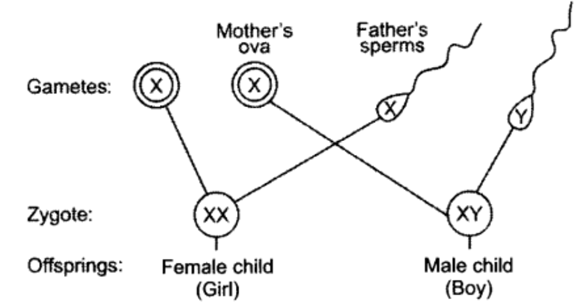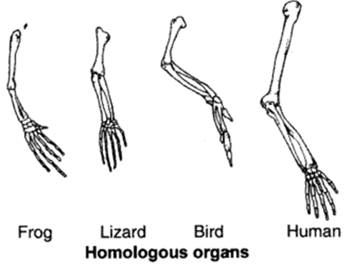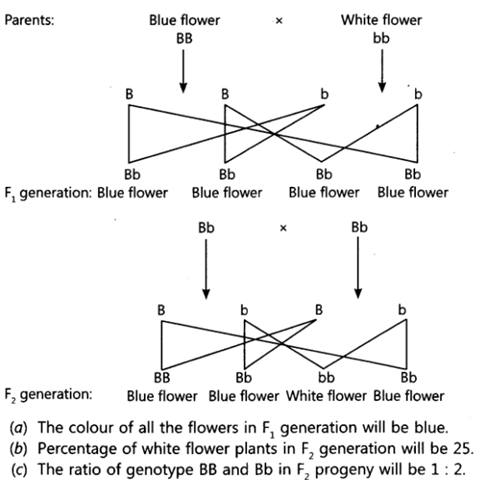Extra Questions for Class 10 Science Chapter 9 Heredity And Evolution
Get extra questions for Class 10 Science Chapter 9 Heredity And Evolution with PDF. Our subject expert prepared these solutions as per the latest NCERT textbook. These extra questions will be helpful to revise the important topics and concepts. You can easily download all the questions and answers in PDF format from our app.
Heredity And Evolution Class 10 Science Extra Questions with Answers
Question 1: What is a gene?
Answer: Gene is the unit of inheritance. Gene is the part of a chromosome which controls the appearance of a set of hereditary characteristics.
Question 2: What is meant by analogous organs? Taking a suitable example, explain how they support the theory of Organic Evolution.
Answer: Analogous organs are those organs which I have different basic structural design and developmental origin but have similar appearance and perform similar functions.
Example: The wings of birds and bats look similar but have different design in their structure. They have a common function of flying but their origins are not common. So, birds and bats are not closely related.
Question 3: What is a sex chromosome?
Answer: Sex chromosome is a chromosome that operates in the sex-determining mechanism of a species. Many animals have two different types of sex chromosomes. For example, in human there is a large X chromosome and a much smaller Y chromosome.
Question 4: “The sex of the children is determined by what they inherit from their father and not their mother.” Justify.
Answer: It is because a child who inherits an X chromosome from her father will be a girl and one who inherits a Y chromosome from his father will be a boy. But all children inherit a X chromosome from their mother regardless of whether they are boys or girls.
Question 5: Define variation in relation to a species. Why is variation beneficial to the species?
Answer: Variation refers to the differences in the characters or traits among the individuals of a species. Variations are beneficial to the species because:
- They enable the organisms to adapt themselves in changing environment.
- Variations form the basis of heredity.
- They form the raw materials for evolution and development of new species.
Question 6: Describe briefly four ways in which individuals with a particular trait may increase in a population.
Answer: The four ways in which individuals with a particular trait may increase in a population are as follows:
- Sexual reproduction results into variations.
- The individuals with special traits survive the attack of their predators and multiply while the other
- will perish.
- Genetic drift provides diversity without any adaptation.
- Variations in the species may lead to increased survival of the individuals.
Question 7: What are fossils? What do they tell us about the process of evolution?
Answer: The remains of dead plants and animals which were buried under the rocks millions of years ago are called fossils.
Fossils tell us about the process of evolution. The fossils of different organisms have some features similar to one species while some features are similar to the other species. In this way, they show the link between two species. They tell us that one species evolves from the other.
Question 8: Give one example each of characters that are inherited and the ones that are acquired in humans. Mention the difference between the inherited and the acquired characters.
Answer: Eye colour or hair colour of a person is an example of inherited character whereas, body weight is an example of acquired character.
The basic difference between inherited and acquired character is that inherited character is passed on from parent to offspring and acquired characters are acquired by an individual during his lifetime depending upon his lifestyle.
Question 9: How is the equal genetic contribution of male and female parents ensured in the progeny?
Answer: During sexual reproduction, a female gamete or egg cell fuses with a male gamete or sperm cell which are haploid to form zygote. Zygote is diploid which contains 23 chromosomes from mother and 23 from father. In this way, an equal genetic contribution of male and female parents is ensured in the progeny.
Question 10: What evidence do we have for the origin of life from inanimate matter?
Answer: Stanley L. Miller and Harold C. Urey provided evidence regarding origin of life from inanimate matter. They assembled an atmosphere similar to that existed on early earth. The atmosphere had molecules like ammonia, methane and hydrogen sulphide, but no oxygen and kept over water at temperature just below 100°C. Sparks were passed through the mixture of gases. At the end of a week, 15% carbon from methane had been converted to simple compounds of carbon like amino acids which make-up protein molecules. So, life arose afresh on earth.
Question 12: Define ‘evolution’. Describe Darwin’s theory of evolution. [All India]
Answer: Evolution is the sequence of gradual changes which take place in the primitive organisms over millions of years and new species are produced. Since, the evolution is of the living organisms, so it is called ‘Organic Evolution’.
Darwin’s theory of Evolution: Charles Robert Darwin gave the theory of evolution in his famous book, ‘The Origin of Species’. The theory of evolution proposed by Darwin is known as ‘The Theory of Natural Selection’. It is also called ‘Darwinism’.
According to Darwin’s theory of evolution:
- There is natural variation within any population and some individuals have more favourable variations than others.
- Population remains fairly constant even though all species produce a large number of off springs.
- This is due to ‘competition’ or struggle for existence between same and different species.
- The struggle for survival within population eliminates the unfit individuals and those with ‘favourable variations’ survive and pass on these variations to their progeny to continue. This is called natural selection.
- The favourable variations are accumulated over a long time period leading to the origin of a new species.
Question 13: Distinguish between acquired and inherited traits by giving one example of each. Why are traits acquired during the lifetime of an individual not inherited?
Answer: Acquired trait is a particular characteristic that is developed during the lifetime of an individual. Such characteristics are not genetically controlled and cannot be passed on to the next generation. Example: Loss of weight due to starvation.
Inherited trait is the transmission of particular characteristics from parents to their off springs, generation to generation. Such traits are genetically determined characteristic that distinguishes a person.
Example: Colour of skin.
The acquired traits cannot change the DNA of the germ cells. Therefore, the acquired traits cannot be inherited over generations during the lifetime of an individual.
Question 14: The human beings who look so different from each other in terms of colour, size and looks are said to belong to the same species. Why? Justify your answer.
Answer: Human beings are said to belong to the same species because of the following reasons:
- DNA studies.
- Number of chromosome is same,
- All have a common ancestor.
- They interbreed among themselves to produce fertile young ones of their own kind.
Question 15: Explain the mechanism of sex determination in humans.
Or
With the help of a flow chart explain in brief how the sex of a newborn is genetically determined in human beings. Which of the two parents, the mother or the father, is responsible for determination of sex of a child?
Answer:

Mechanism of Sex Determination in Human Beings:
In human beings, the sex of the individual is genetically determined.
- Sex determination is the process by which sex of a new born individual can be determined.
- Human beings have 1 unpaired sex chromosome. Sex chromosome of male is XY and of female is XX.
- Sex of a child depends on what happens at fertilisation.
Thus, father is responsible for the determination of the sex of a child.
Question 16: With the help of suitable examples explain natural selection.
Answer: Let us assume that there exist a group of red beetles in some green bushes. Due to variation during sexual reproduction one green beetle evolved among them. This green beetle can pass the colour to its progeny which are green beetles.
Crows cannot see green beetles in green bushes and therefore, cannot eat them. The progeny of green beetles are not eaten while the progeny of red beetles continued to be eaten. As a result there are more and more green beetles in the beetle population. The progeny of green beetles increase due to natural selection which gives survival advantage.
Question 17: Explain the terms: (i) Speciation (ii) Natural selection
Answer: (i) Speciation is the evolution of reproductive isolation among once-interbreeding populations, i.e. the development of one or more species from an existing species.
(ii) Natural selection is the process, according to Darwin, which brings about the evolution of new species of animals and plants.
Question 18: Explain with examples how the following are evidences in favour of evolution in organisms. (i) Homologous organs (ii) Analogous organs (iii) Fossils
Answer: (i) Forelimb of human and bird are homologous organs. They have same structural design and developmental origin but they have different functions and appearance. Homologous organs help us to understand that the organism has evolved from a common ancestor. The more common characteristics the two species have, the more closely they are related.
(ii) Analogous organs are those organs design and developmental origin but have similar appearance and perform similar functions.
Example: The wings of birds and bats look similar but have different design in their structure. They have a common function of flying but their origins are not common. So, birds and bats are not closely related.
(iii) Fossils and their study is useful in knowing about the species which are no longer alive. They provide evidence and missing links between two classes. They are helpful in forming a sequence of organisms in the pathway of evolution. Thus, fossils have an importance in deciding evolutionary relationship. Archaeopteryx is a fossil bird. It had feathers, fused bones and beak which are exclusively bird structures. It also had some features which are found in reptiles, e.g. teeth in jaw, claws on free fingers and a long tail. This fossil provides a clue that birds have evolved from reptiles.
Question 19: Give an example of body characteristics used to determine how close two species are in terms of evolution and explain it.
Answer: Homologous organs help to identify the relationship between organisms. These characteristics in different organisms would be similar because they have inherited from a common ancestor.
For example, forelimbs of human and wings of birds show closeness between the two species because the organs have similar basic structural design of limbs though it has been modified to perform different functions.
Question 20: What are homologous organs? Can the wing of a butterfly and the wing of a bat be regarded as homologous? Why?
Answer: Homologous organs are those organs which have the same basic structural design and developmental origin but have different functions and appearance.
Example: The forelimb of a frog, a lizard, a bird and a man seem to be built from the same basic design of bones, but they perform different functions.

No, the wing of a butterfly and the wing of a bat cannot be considered homologous organs because they have a common function for flying but their origin and structure are not common. So, they are analogous organs.
Question 21: What is meant by the term speciation? List four factors which could lead to speciation.
Answer: Speciation is the evolution of reproductive isolation among once interbreeding population.
Factors which can lead to speciation are:
- Genetic drift: Over generations, genetic drift may accumulate which leads to speciation.
- Natural selection: Natural selection may work differently in different location which may give rise to speciation.
- Severe DNA change.
- A variation may occur which does not allow sexual act between two groups.
Question 22: Distinguish between homologous organs and analogous organs. In which category; would you place wings of a bird and wings of a bat? Justify your answer giving a suitable reason.
Answer:
| Homologous Structure | Analogous Structure |
| Similar anatomy | Dissimilar anatomy |
| Dissimilar functions | Similar Functions |
| Inherited from a common ancestor | Not inherited from ancestors |
| Develops in related species | Develops in unrelated species |
| A result of divergent evolution | A result of convergent evolution |
| Developed as a result of the adaptation to a different environment | Developed as a result of the adaptation to a similar environment |
| An arm of a human, the leg of a dog or a flipper of a whale are all homologous structures | From wings in birds, bats and insects to fins in penguins and fishes are all analogous structures |
Wings of a bird and wings of a bat are analogous organs as they have different basic structural design but have similar appearance and perform similar functions.
Question 23: A blue colour flower plant denoted by BB is cross breed with that of white colour flower plant denoted by bb.
(a) State the colour of flower you would expect in their F1 generation plants.
(b) What must be the percentage of white flower plants in F2 generation if flowers of F1 plants are self-pollinated?
(c) State the expected ratio of the genotypes BB and Bb in the F2 progeny. [Delhi]
Answer:

Question 24: Define the term ‘evolution’. “Evolution cannot be equated with progress”. Justify this statement.
Answer: Evolution is the sequence of gradual change which takes place in primitive organisms over millions of years and new organisms are formed. Evolution cannot be equated to progress from lower forms to higher forms. It seems to have given rise to more complex body designs even while the simpler body designs continue to flourish. For example, human beings have not evolved from chimpanzees, but both have common ancestor.
Question 25: If we cross pure-bred tall (dominant) pea plant with pure-bred dwarf (recessive) pea plant we will get pea plants of F1 generation. If we now self-cross the pea plant of F2 generation, then we obtain pea plants of F2 generation.
(a) What do the plants of F2 generation look like?
(b) State the ratio of tall plants to dwarf plants in F2 generation.
(c) State the type of plants not found in F2 generation but appeared in F2 generation, mentioning the reason for the same.
Answer: (a) All plants of F1 generation will be tall plants.
(b) 3:1
(c) Dwarf trait is recessive trait which was not expressed in the F1 generation, the recessive trait gets expressed in the F2 generation after self-pollination.
Question 26: How are fossils formed? Describe, in brief, two methods of determining the age of fossils.
Answer: When organisms die, their bodies decompose due to action of microorganisms. However, sometime the body or at least some parts of the body may be in such an environment that does not let it decompose completely. All such preserved traces of living organisms are called fossils. The age of fossils can be estimated by the following two methods:
- If we dig into the earth and start finding fossils, it can be assumed that the fossils closer to the surface are more recent to those found in deeper layers.
- By detecting the ratios of different isotopes of the same element in the fossil material.
Question 27: State the meaning of inherited traits and acquired traits. Which of the two is not passed on to the next generation? Explain with the help of an example.
Answer: Inherited traits are the characteristics transmitted from parents to their offspring. Acquired traits are characteristics which are developed during the lifetime of an individual. Acquired traits are not passed on to the next generation. For example, if we breed a group of mice, all their progeny will have tails. Now, if the tails of these mice are removed by surgery and allowed to breed, the next generation mice will also have tails. If these tails are also removed and allowed to breed, the progeny of mice will again have tails. Removal of tail by surgery is an acquired trait and do not change the genes of germ cells and hence, are not passed on to the next generation.
Question 28: “An individual cannot pass on to its progeny the experiences of its lifetime.” Justify the statement with the help of an example and also give reason for the same.
Answer: Experience achieved during the lifetime of an individual does not make any change in the gene of the individual.
For example: if a person reads a book on birds, the knowledge he earns by reading the book does not make any change in the gene, hence, this knowledge will not get automatically transmitted to his next generation. Such a trait is called acquired trait.